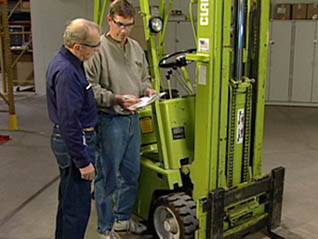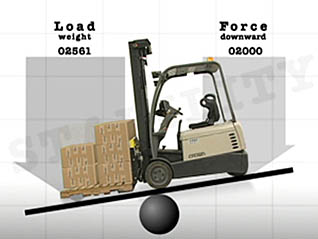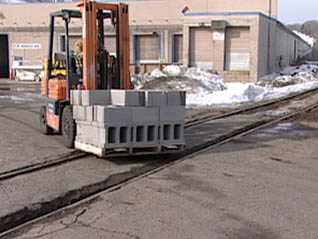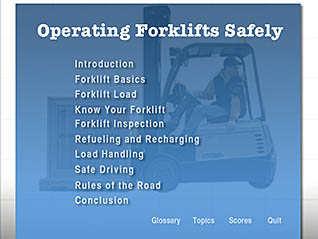Forklift: Operating Forklifts Safely
- Product ID
- auroofsa
- Training Time ?
- 50 to 100 minutes
- Language(s)
- English
- Video Format
- Standard Definition
- Required Plugins
- MasteryNet Player
- Lesson Interactions
- 13
- Quiz Questions
- 37
- Closed Captioning



This new training program identifies the characteristics of a forklift and its safe operating procedures. Using reenactments of forklift accidents and incidents, learners comprehend the need to operate these machines safely.
Training explores incident prevention techniques by knowing how your forklift operates; inspecting and fueling/charging, properly lifting, carrying, and placing the load; and driving safely. The course also identifies hazardous driving conditions, procedures to loading trucks and rail cars, and guidelines when working near pedestrians and other forklifts.
![]() This course is in the Advantage™ format, to read about Advantage™ features click here.
This course is in the Advantage™ format, to read about Advantage™ features click here.



- Install on any SCORM LMS
- Rich multimedia presentation with interactions and quiz
- Print certificate and wallet card
- You have 30 days to complete the course
Anyone operating or learning to operate a forklift.
-
Introduction
- Importance of forklifts
-
Forklift Basics
- Forklift steering
- Difference between cars and forklifts
-
The Forklift Load
- Load stability
- Forklift load limit
- Examples of unstable loads
- Elevated load stability
-
Familiarity with your Forklift
- A confused forklift operator
- Fork attachments
- Components to be familiar with
- Specific workplace hazards
-
Forklift Inspection
- When forklifts should be inspected
- Forklift components to inspect
- Testing operation of components
- Procedures when defects are found
-
Refueling and Recharging
- Preparation for refueling or recharging
- PPE when handling electrolytes
- Refueling and recharging precautions
-
Load Handling
- A forklift mishap
- Picking up a load
- Picking up an elevated load
- Placing a load
- Overhead hazards
-
Safe Driving
- Forklift mishap
- Carrying a stable load
- Precautions when carrying a load
- Loads that block forward view
- Conditions that present driving hazards
- Crossing railroad tracks
- Driving on slopes or ramps
- Loading into trailers or railcars
-
Rules of the Road
- Near miss with pedestrian
- Approaching intersections
- Approaching blind spots
- No riders
- Pedestrian precautions
- Traveling near other forklifts
- Unattended forklifts
-
Conclusion
- Conclusion
-
Explain key differences between forklifts and cars.
- Describe how rear steering affects forklift operation.
- List the effects of short forklift wheelbase and no shocks or springs.
-
Select and position the forklift load for maximum safety and stability.
- Describe load position for greatest stability and lifting capacity.
- Identify where forklift load limit is found.
- Describe how increased load weight affects traction.
- List examples of unstable loads.
- Describe how load height affects stability.
-
Describe forklift features to understand before operating a forklift.
- Recognize that forklifts can have different fork attachments.
- Explain the need for familiarity with instruments and controls.
- Describe power sources for forklift motors.
- Explain where to find instructions and precautions on a forklift.
- Recognize forklift fire, explosion, and exhaust hazards.
-
Perform effective forklift inspection.
- Recall when inspections should take place.
- List examples of damage and defects to identify.
- List operational components to test.
- Describe steps to take if problems are found.
-
Safely perform forklift refueling or recharging.
- Describe recharging and refueling preparation.
- List examples of PPE for battery work.
- State refueling precautions.
-
Perform load handling procedures safely.
- Describe correct procedures for picking up a load.
- Restate procedures for picking up an elevated load.
- Describe procedures for placing a load.
- List examples of overhead hazards.
-
Safely drive a loaded forklift.
- Restate the most stable load position during transport.
- Identify proper stopping and cornering procedures.
- Describe how to safely transport loads that block the forward view.
- List surface conditions that affect forklift stability.
- Describe the safest way to cross railroad tracks.
- Explain procedures for traveling on slopes and ramps.
- Identify trailer and railcar loading procedures.
-
Safely drive forklifts while in the vicinity of pedestrians and other forklifts.
- Describe proper driving procedures at intersections.
- Explain precautions to take when approaching a blind spot
- Recognize that forklifts should not lift or transport passengers.
- Identify precautions to take when driving near pedestrians.
- Explain precautions to take when driving near other forklifts.
- List precautions to follow regarding unattended forklifts.
© Mastery Technologies, Inc.




